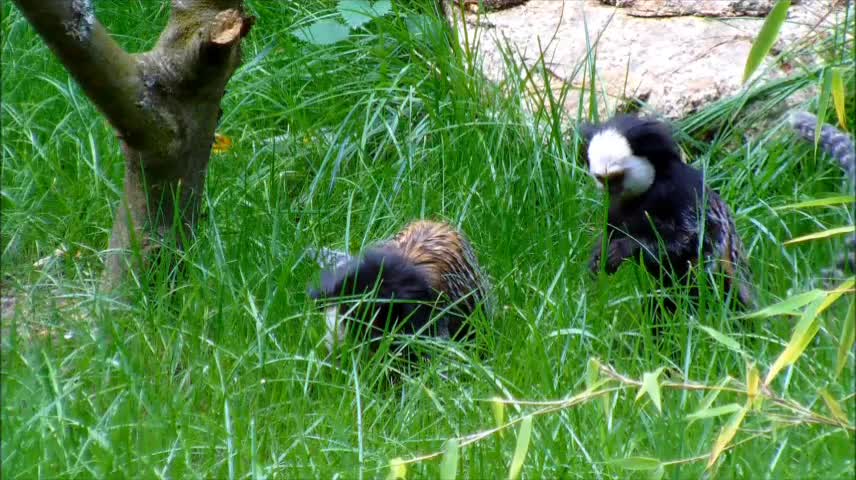Premium Only Content

Two Marmoset in grass.
The marmosets (/ˈmɑːrməˌzɛts, -ˌsɛts/),[3][4] also known as zaris or sagoin, are 22 New World monkey species of the genera Callithrix, Cebuella, Callibella, and Mico. All four genera are part of the biological family Callitrichidae. The term "marmoset" is also used in reference to Goeldi's marmoset, Callimico goeldii, which is closely related.
Marmosets[1][2]Common marmoset (Callithrix jacchus) at Tibau do Sul, Rio Grande do NorteScientific classificationKingdom:AnimaliaPhylum:ChordataClass:MammaliaOrder:PrimatesSuborder:HaplorhiniInfraorder:SimiiformesParvorder:PlatyrrhiniFamily:CallitrichidaeGroups included
Callibella M.G.M. van Roosmalen & T. van Roosmalen, 2003 (Roosmalens' dwarf marmoset)
Callimico Miranda-Ribeiro, 1922 (Goeldi's marmoset)
Callithrix Erxleben, 1777 (Atlantic marmosets)
Cebuella Gray, 1866 (pygmy marmosets)
Mico Lesson, 1840 (Amazonian marmosets)
Cladistically included but traditionally excluded taxa
Leontopithecus Lesson, 1840 (lion tamarins)
Saguinus Hoffmannsegg, 1807 (tamarins)
Most marmosets are about 20 cm (8 in) long. Relative to other monkeys, they show some apparently primitive features; they have claws rather than nails, and tactile hairs on their wrists. They lack wisdom teeth, and their brain layout seems to be relatively primitive. Their body temperature is unusually variable, changing by up to 4°C (7°F) in a day.[5] Marmosets are native to South America and have been found in Bolivia, Brazil, Colombia, Ecuador, Paraguay, and Peru.[6] They have also been occasionally spotted in Central America and southern Mexico.[7] They are sometimes kept as pets, though they have specific dietary and habitat needs that require consideration.[8]
According to recent research, marmosets exhibit germline chimerism, which is not known to occur in nature in any primates other than callitrichids.[9] 95% of marmoset fraternal twins trade blood through chorionic fusions, making them hematopoietic chimeras.[10][11]
Contents
EtymologyEdit
Callithrix comes from Ancient Greek and means "beautiful fur".
Species listEdit
Genus Callithrix—Atlantic marmosets
Common marmoset, Callithrix jacchus
Black-tufted marmoset, Callithrix penicillata
Wied's marmoset, Callithrix kuhlii
White-headed marmoset, Callithrix geoffroyi
Buffy-headed marmoset, Callithrix flaviceps
Buffy-tufted marmoset, Callithrix aurita
Genus Mico—Amazonian marmosets
Rio Acari marmoset, Mico acariensis
Silvery marmoset, Mico argentatus
White marmoset, Mico leucippe
Emilia's marmoset, Mico emiliae
Black-headed marmoset, Mico nigriceps
Marca's marmoset, Mico marcai
Black-tailed marmoset, Mico melanura
Santarem marmoset, Mico humeralifer
Maués marmoset, Mico mauesi
Munduruku marmoset, Mico munduruku
Gold-and-white marmoset, Mico chrysoleucos
Hershkovitz's marmoset, Mico intermedius
Satéré marmoset, Mico saterei
Rondon's marmoset, Mico rondoni
Genus Callibella—Roosmalens' dwarf marmoset
Roosmalens' dwarf marmoset, Callibella humilis
Genus Cebuella—Pygmy Marmoset
Pygmy marmoset, Cebuella pygmaea
BehaviorEdit
Marmosets are highly active, living in the upper canopy of forest trees, and feeding on insects, fruit, leaves, tack, sap, and gum. They have long lower incisors, which allow them to chew holes in tree trunks and branches to harvest the gum inside; some species are specialised feeders on gum.[citation needed]
Marmosets live in family groups of three to 15, consisting of one or two breeding females, an unrelated male, their offspring, and occasionally extended family members and unrelated individuals. Their mating systems are highly variable and can include monogamy, polygyny, and polyandry. In most species, fraternal twins are usually born, but triplets are not unknown. Like other callitrichines, marmosets are characterized by a high degree of cooperative care of the young and some food sharing and tolerated theft. Adult males, females other than the mother, and older offspring participate in carrying infants. Father marmosets are an exceptionally attentive example of fathers within the animal kingdom, going as far as assisting their mates in giving birth, cleaning up afterbirth, and even biting the umbilical cords attaching their newborn offspring to their mothers. Most groups scent mark and defend the edges of their ranges, but if they are truly territorial is unclear, as group home ranges greatly overlap.
The favorite food of marmosets is carbohydrate-rich tree sap, which they reach by gnawing holes in trunks. Their territories are centered on the trees that they regularly exploit in this way. The smaller marmosets venture into the very top of forest canopies to hunt insects that are abundant there.[7]
ReferencesEdit
^ Groves, C. P. (2005). Wilson, D. E.; Reeder, D. M. (eds.). Mammal Species of the World: A Taxonomic and Geographic Reference(3rd ed.). Baltimore: Johns Hopkins University Press. pp. 129–133. ISBN 0-801-88221-4. OCLC 62265494.
^ Garber, Paul A.; Estrada, Alejandro; Bicca-Marques, Júlio César; Heymann, Eckhard W.; Strier, Karen B., eds. (2008). "The Diversity of the New World Primates (Platyrrhini): An Annotated Taxonomy". South American Primates: Comparative Perspectives in the Study of Behavior, Ecology, and Conservation: Developments in Primatology: Progress and Prospects. Springer. pp. 23–54. ISBN 978-0-387-78704-6.
^ "marmoset". Merriam-Webster Dictionary. Retrieved 2016-01-21.
^ "marmoset". Oxford Dictionaries UK English Dictionary. Oxford University Press. n.d. Retrieved 2016-01-21.
^ Stafford, S.G. (1999). "Thermoregulatory and Endocrine Adaptations of Small Body Size in Primates". Kent State University Dissertation, QP 135.S73, 1999.
^ Primate Info Net, Callithrix Factsheet, University of Wisconsin, Madison.
^ a b "The Primates: New World Monkeys". Archived from the original on 2005-12-11. Retrieved 2005-12-06.
^ March 2017, Alina Bradford 29 (29 March 2017). "Facts About Marmosets". livescience.com. Retrieved 2020-11-16.
^ Ross, C.N., French, J.A., and Ortí, G. (2007). "Germ-line chimerism and paternal care in marmosets (Callithrix kuhlii)". Proc. Natl. Acad. Sci. USA. 104 (15): 6278–82. Bibcode:2007PNAS..104.6278R. doi:10.1073/pnas.0607426104. PMC 1851065. PMID 17389380.
^ Masahito Tachibana, Michelle Sparman and Shoukhrat Mitalipov (January 2012). "Generation of Chimeric Rhesus Monkeys". Cell. 148 (1–2): 285–95. doi:10.1016/j.cell.2011.12.007. PMC 3264685. PMID 22225614.
^ Gengozian, N.; Batson, JS; Eide, P. (1964). "Hematologic and Cytogenetic Evidence for Hematopoietic Chimerism in the Marmoset, Tamarinus Nigricollis". Cytogenetics. 10 (6): 384–393. doi:10.1159/000129828. PMID 14267132.
-
 LIVE
LIVE
Film Threat
13 hours agoWOLF MAN + PETER PAN'S NEVERLAND NIGHTMARE + MORE GORE! | Film Threat Livecast
163 watching -
 LIVE
LIVE
Tudor Dixon
2 hours agoHypocrisy and Accountability in Politics with Sen. Markwayne Mullin | The Tudor Dixon Podcast
220 watching -
 LIVE
LIVE
The Shannon Joy Show
3 hours ago🔥🔥Live EXCLUSIVE With Edward Dowd: Trump CANNOT Stop The Worldwide Economic Collapse🔥🔥
241 watching -
 1:03:32
1:03:32
The Dan Bongino Show
3 hours agoTrump Joins The Show To Drop Massive Truth Bombs (Ep. 2403) - 01/17/2025
205K615 -
 LIVE
LIVE
Right Side Broadcasting Network
3 days agoLIVE: RSBN Pre-Inauguration Coverage: Day Two Live from Washington D.C. - 1/17/25
3,132 watching -
 21:42
21:42
The Rubin Report
1 hour ago‘Piers Morgan’ Panelists' Jaws Drop as Liberal’s Entire Narrative Obliterated w/ One Question
13.3K11 -
 1:37:57
1:37:57
Steven Crowder
3 hours ago🔴 MAGA: T-Minus Three Days | Everything We Want President Trump to do on Day One
153K69 -
 1:14:04
1:14:04
Dave Portnoy
19 hours agoThe Unnamed Show With Dave Portnoy, Kirk Minihane, Ryan Whitney - Episode 42
35K5 -
 LIVE
LIVE
LFA TV
16 hours agoREBUILD PEDOWOOD! | LIVE FROM AMERICA 1.17.25 11am
5,157 watching -
 LIVE
LIVE
Caleb Hammer
18 hours agoI've Never Hated A More Vile Piece of Trash | Financial Audit
285 watching